Molly Larkin's Blog, page 12
October 21, 2015
Little told stories of medicine men and medicine women
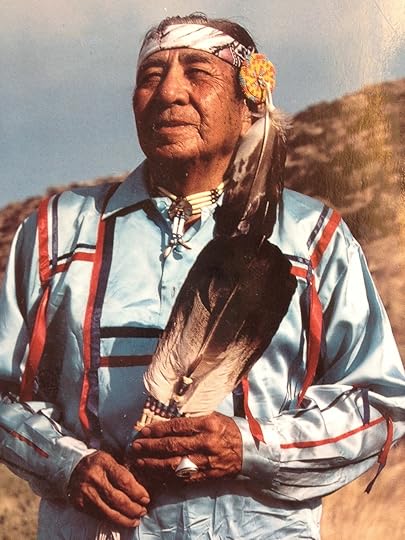
 The iconic view of “medicine men” is that of healing. But their abilities often go far beyond the healing arts.
The iconic view of “medicine men” is that of healing. But their abilities often go far beyond the healing arts.
The following is an excerpt from The Wind Is My Mother,” as told by Bear Heart.
The Creek Tribe had about as many medicine women as men and their knowledge and abilities went far beyond the healing arts.
In the old days, when our medicine people were not doctoring their patients or away on some quest, they would occasionally get together and take some time for themselves, meeting and drinking and kind of letting off steam.
I don’t know where they got the liquor because in those days it was illegal for Indians to drink but they managed it somehow. They didn’t do this all the time, just every now and then as it was one of their ways of staying connected with the earth and humanity.
My mother told me about how they would show off in front of one another while they were drinking. As a child she saw one instance where one of them took a whisky bottle, said a chant, blew on the bottle, physically twisted the glass in his hands and set it down — it was still glass, but it was as though it became something else in his hands, something which allowed itself to be re-shaped.
Another one took his belt off, blew on it, flung it on the floor and it turned into a live snake. Those are just some of the things they did, kind of like boys showing off to one another:
“I can do this.”
“That’s nothing, watch this.”
But they would also have occasion to perform such feats in the normal course of their responsibilities, such as preparing a delegate from the tribe to go to Washington.
You may remember in the old Westerns how the President of the United States was known to the Indian people as the “Great White Father.”
We could never understand why very few Indians were ever allowed to see the “Great White Father” in person — the representatives of the Great White Father could talk to the chief of the tribe, but our chief could never confront the head man of the white nation, there always had to be a go between.

In order to choose which medicine man would attend to the delegate, or perhaps even accompany him to Washington, they would all sit around in a circle, put a feather between them and try out their powers. The one who could fly that feather the highest got the job.
When I was a small boy, I saw one instance where one made that feather move, then another made it stand on end. When it came to my mother’s uncle, the feather just zipped straight up, several feet in the air, so he was the one designated to help the delegate.
Once the medicine man was chosen he would fix an herb for the delegate to put in his mouth so that when he spoke he would be eloquent and clear in his presentation.
And at the same time that medicine would also be fixed in such a way that his words would be heard by his audience as being worthy of consideration.
Sometimes a medicine person would also fix face paint so that the delegate would be noticed out of a crowd of people and be looked upon with respect and favor.
Those are just a few of the things that our medicine people used to do in addition to doctoring people.
October 7, 2015
The urban legend of the right to bear arms

The more something is repeated, even if untrue, the more it will be believed. This is particularly true of the belief that the Second Amendment of the U.S. Constitution gives individuals the “right to bear arms.”
The Second Amendment, passed by Congress in 1789, consists of one poorly crafted sentence: “A well regulated militia, being necessary for the security of a free state, the right of the people to keep and bear arms, shall not be infringed.”
For 200 years, it was understood that the Second Amendment only gave an individual the right to bear arms within an organized militia.
This changed in the 1970s after a methodical political campaign by the National Rifle Association [NRA] led to its being reinterpreted by the U.S. Supreme Court.
Read on to understand how this came about.
According to the Huffington Post, last week’s mass shooting in Oregon was the 265th mass shooting in the U.S. in 2015. That’s not a typo.
Most mass shootings don’t even make the news any more – they have become that commonplace.
A study by the University of Alabama Department of Criminal Justice found that countries with higher rates of gun ownership recorded more mass shooters per capita. The U.S. ranks first in gun ownership per capita in the world.
The history of the NRA and the “right to bear arms”
The NRA was originally formed after the Civil War by a group of Union officers in order to sponsor better markmanship.
The NRA’s principal focus was spelled out on it’s headquarter’s building:
firearms safety education,
marksmanship training,
shooting for recreation.
According to Michael Waldman’s well researched article: “How the NRA Rewrote the Second Amendment,” there was a revolt in the NRA in 1977 when the organization moved its headquarters to Colorado from Washington, which was interpreted as distancing itself from politics. Over a thousand dissenters voted out the leadership, and activists from the Citizens Committee for the Right to Keep and Bear Arms took over.
Today, the NRA’s Virginia headquarters has an incomplete sentence on a wall of the building: “…the right of the people to keep and bear arms, shall not be infringed.”
The reference to a “well-regulated militia” has been omitted.
Every law review article on the Second Amendment indexed from 1888 through 1959, concluded it did not guarantee an individual the right to bear arms.
Starting in the 1970s, the new NRA funded articles, contests, grants and endowments to promote its re- interpretation of the Second Amendment.
In addition to politicians being swayed, so was the public:
In 1959, according to a Gallup poll, 60 percent of Americans favored banning handguns; that dropped to 41 percent by 1975 and 24 percent in 2012.
By early 2008, according to Gallup, 73 percent of Americans believed the Second Amendment “guaranteed the rights of Americans to own guns” outside the militia.
Bending to political pressure, in 2008, the U.S. Supreme Court re-interpreted the Second Amendment in District of Columbia v. Heller and guaranteed individuals the right to own a weapon.
Should we arm teachers?
Many of these tragic mass shootings take place in schools, and some gun activists advocate arming teachers. I believe this is a very, very bad idea.
“While there are no specific data regarding having armed adults in schools, an analysis of U.S. mortality data found that people with guns in the home are at greater risk than those without guns in the home of dying from a homicide there. There is no reason to think schools would be any different: the more guns there are, the more opportunities there are to use them.” Time Magazine: 12/21/12: http://ideas.time.com/2012/12/21/viewpoint-arming-teachers-isnt-the-answer/
Research shows that the only way to make good decisions under pressure [such as facing a gunman], is to be under such pressure on a regular basis and learn to thrive under it.
I think school teachers have better things to do, and probably don’t have the temperament, to want to thrive under such pressure.
The definition of insanity and the right to bear arms
Stephen Colbert, host of the Late Show, said this on the Oregon shootings:
“I can’t pretend that it didn’t happen. I also can’t pretend to know what to do to prevent what happened yesterday all the times it has happened before. But I think pretending is part of the problem. These things happen over and over again and we’re naturally horrified and shocked when we hear about them, but then we change nothing, and we pretend that it won’t happen again.
“Some say the answer is stricter gun laws and others say the answer is mental health care, that we need better treatment, or to keep the guns out of the hands of the insane. Maybe it’s both, I honestly don’t know.
“But I do know that one of the definitions of insanity is changing nothing and pretending that something will change.”
Here are two successful examples of change as the result of tragedy:
There was a time when all refrigerators in the U.S. could only be opened by the handle on the outside, and many children died by being suffocated in abandoned refrigerators. So laws were passed requiring manufacturers to make safer refrigerators and consumers to safely dispose of their refrigerators. At no point did the National Refrigerator Association step in and try to stop this. And now refrigerator deaths aren’t a problem any more.
A 1996 gun massacre in Australia left 35 dead. Australia then banned semiautomatic and automatic rifles and shotguns. The gun homicide rate fell by 59% and the gun suicide rate fell by 65%, without a parallel increase in non-firearm homicides and suicides.
In 1991, Conservative Supreme Court Chief Justice Warren Burger had this to say about the gun lobby’s re-interpretation of the Second Amendment:
“The Gun Lobby’s interpretation of the Second Amendment is one of the greatest pieces of fraud, I repeat the word fraud, on the American People by special interest groups that I have ever seen in my lifetime. The real purpose of the Second Amendment was to ensure that state armies – the militia – would be maintained for the defense of the state. The very language of the Second Amendment refutes any argument that it was intended to guarantee every citizen an unfettered right to any kind of weapon he or she desires.”
I would suggest it’s time to change the interpretation of the Second Amendment back to how it stood for the first 200 years. And let’s see how many lives are saved.
Sources for this article:
http://www.newyorker.com/news/daily-comment/so-you-think-you-know-the-second-amendment
Dead or Alive: Originalism As Popular Constitutionalism in Heller” by Reva B. Siegel http://digitalcommons.law.yale.edu/cgi/viewcontent.cgi?article=2132&context=fss_papers
http://www.politico.com/magazine/story/2014/05/nra-guns-second-amendment-106856
http://www.wsj.com/articles/u-s-leads-world-in-mass-shootings-1443905359
http://www.huffingtonpost.com/entry/gun-violence-senate-republicans_56141558e4b0baa355ad8f37
http://www.gunviolencearchive.org/reports/mass-shooting?page=10
September 23, 2015
7 reasons why kindness matters
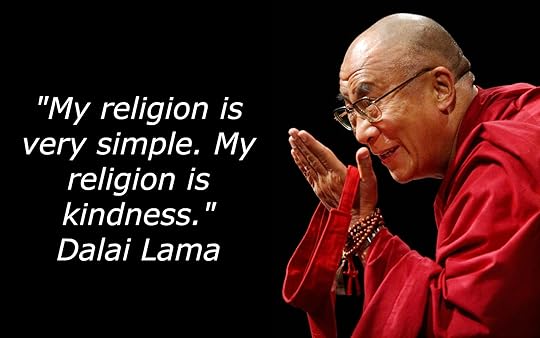
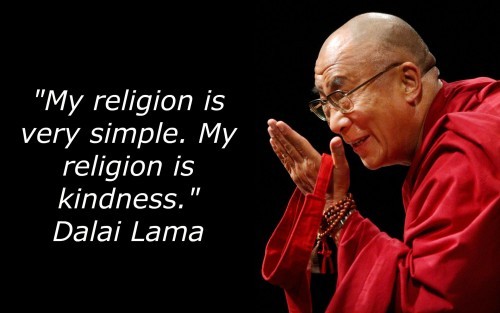 “My religion is very simple. My religion is kindness.” Dalai Lama
“My religion is very simple. My religion is kindness.” Dalai Lama
Does kindness matter?
I think so, and there are compelling reasons to make it a priority in our lives, for the world needs it now more than ever.
A few months ago, while watching television in a hotel in the Midwestern United States, I saw a commercial for a local program which mentors the elderly.
I heard the narrator say, “One of the ways we mentor the elderly is take them out and teach them how to shoot squirrels.”
Seriously? Mindless killing of animals just to pass the time? That really breaks my heart.
Even more amazing was that this aired less than one week after the uproar over the killing of Cecil the lion in Zimbabwe.
“The idea that some lives matter less is the root of all that is wrong with the world.” Paul Farmer
7 reasons why kindness matters
Research shows that repeated acts of kindness:
Makes you happier.
Improves your immune system and health.
Lowers the rate of depression .
Makes you feel more creative.
Causes employees to want to work harder for employers.
Increases the endogenous opioids in the brain, giving us a natural high.
Create the feeling of “emotional warmth,” producing the hormone oxytocin which in turn helps reduce blood pressure and protects the heart.
I had a friend with a very successful dental practice who had his receptionists practice answering the phone in front of a mirror with a smile on their face. Why? Because that warm emotion of smiling would come across in their voices as they answered the phone, making the caller feel welcomed.
I know that given a choice between doing business with a company with a friendly receptionist and a grumpy one, I will always choose the former.
“A warm smile is the universal language of kindness.” William Arthur Ward.
Ways to manifest kindness
Kindness to ourselves
This is probably the hardest thing for a person to achieve. Kindness to self includes:
Self-care.
Learning when to say, “no.”
A healthy diet.
Getting a good night’s sleep every night.
Stopping negative self-talk.
Giving yourself compliments every day!
Laughing regularly.
Letting yourself cry.
Playing
Meditating
Kindness to strangers
On a personal level, everyone we meet is facing some kind of challenge we know nothing about. A simple smile or act of kindness might make their whole day, and it costs us nothing.
Look strangers in the eye and give them a smile and a thank you. The clerk behind the checkout counter at the grocery store – did you look them in the eye? Would you recognize them again if you passed them on the street?
Greeting someone new in the neighborhood, office or church will make them feel welcomed and helps create a sense of community.
Exhibiting kindness to strangers can go a long way towards solving the world’s problems.
We are all aware of the tragedy of the Syrian refugees trying to escape certain death in Syria and yet with nowhere to go. The irony is that, if each country would display an act of kindness, open its doors, and welcome just a few, the crisis would be solved.
Pope Francis encouraged every single Catholic parish in Europe to “take in one migrant family.” This call to the region’s approximately 120,000 parishes would solve the problem with ease.
“In front of the tragedy of the tens of thousands of refugees escaping death by war or hunger, on the path towards the hope of life, the Gospel calls us, asks us to be ‘neighbors’ of the smallest and most abandoned.” Pope Francis
Kindness matters, and kindness multiplies exponentially when we all contribute to it.
“It is in the shelter of each other that the people live.” – Irish proverb
Kindness to animals
“We should have respect for animals because it makes better human beings of us all.” Dr. Jane Goodall
Animals are sentient beings. Indigenous peoples around the world understand that, teach that, and live their lives with animals as their teachers, companions and guides.
Yes, animals will be killed for food, but first there is a prayer ceremony to ask the animal to be willing to give it’s life, and the emphasis is on teaching hunters to kill quickly, painlessly, with a first strike of a bullet or arrow.
And the Original Peoples never took more than they needed. That is a manifestation of kindness.
Who and where are we?
Kindness matters more than we think. One day our very lives may depend on it.
Viewed from space, there are no borders separating countries on Earth. We are all just one human race, trying to survive on a planet hurtling around the sun at 67,000 miles per hour.
It’s rather amazing we’re still here. Tragedies happen every day. One could happen to you, and you will be forever grateful to the person who offers you kindness and a friendly hand.
Why not pay it forward?
“I’ve learned that people will forget what you said, people will forget what you did, but people will never forget how you made them feel.” Maya Angelou
September 9, 2015
Why sedentary workaholics need a healthy diet

 Guest post by Vaileria Dennis.
Guest post by Vaileria Dennis.
A workaholic is a person who works for longer hours than the average person. A sedentary lifestyle is a type of lifestyle with no or irregular physical activity.
A person who lives a sedentary lifestyle may colloquially be known as a “couch potato.” Sedentary activities include sitting, reading, watching television, playing video games, and computer use for much of the day with little or no vigorous “no-equipment physical exercise.”
A sedentary lifestyle and lack of physical activity can contribute to or be a risk factor for:
Anxiety
Cardiovascular disease
Mortality in elderly men by 30% and double the risk in elderly women
Deep vein thrombosis
Depression
Diabetes
Colon cancer
High blood pressure
Obesity
Osteoporosis
Lipid disorders
Kidney stones
Corporal Syndrome
Frequent Back and neck pain or pinched nerve
Spinal disc herniation (Lower back pain)
This is not to be interpreted to mean that those who lead such a lifestyle are doomed to suffer from the above conditions. It’s only that they are at higher risk than people who get moving. By planning the diet well, the negatives of this lifestyle can be alleviated.
Case study on a workaholic and diet
Take, for example, George: an IT enthusiast who spends the entire day with his computer. He loves surfing the internet and learning about new trends in the IT world.
He only works as an online freelancer thus basically spending his time online rendering his services to the clients. Due to time disparities, he is forced to work late at night with clients who weren’t available during the day.
He is a workaholic. With such a life, it is hard for George to be involved in physical activities as much time is spent sitting. The possibility of his getting any of the above conditions is higher for him. As a result, George needs to plan his diet in the following ways to minimize this possibility:
Calorie Requirements
The daily calorie requirement for people with sedentary lives depends on their body frame, weight, gender, and height. George needs to consume 2200 to 2400 calories per day.
Diet Recommendations
The diet of people who are sedentary should incorporate 45% to 65% carbohydrate, 15% protein, and 30% to 35 % fat. People with a sedentary lifestyle should consume more carbohydrates as the main base of their diets.
Instead of simple, refined carbs, healthy, complex carbs such as fruits, vegetables, whole grain, whole wheat products, whole cereals, whole pulses, beans, legumes, etc. are recommended.
George should adhere to the following:
Protein Intake
George is required to include good sources of protein such as eggs, low-fat dairy products, and poultry without skin, lean meat, and fish in his daily diet. Good fat forms will ensure he does not gain weight.
Dairy products intake
George is also required to eat low-fat dairy products such as yogurt, cheese, and skim milk. Monounsaturated and polyunsaturated fat forms are high sin omega 3 fatty acids and are good options. Seeds, olive oil, and nuts are good sources of healthy fat forms. He should ensure to include all food groups daily to gain all vitamins and minerals in the diet.
Water intake
It is necessary to drink plenty of water. Eight glasses will do just fine. He should ensure to drink calorie-free water most of the time.
Fresh fruits and salads
He is to substitute fruits and salads for salty, fatty snacks.
Practical Diet Example That George May Follow:
Vegetables, 3 cups
Fruits, 2 cups
Grains, 8 ounces
High protein foods, 6.5 ounces
Dairy foods, 3 cups Oil, 7 teaspoons
In addition to this, he can eat 330 extra calories each day.
George should avoid unhealthy fat forms. These fat forms also increase LDL cholesterol level. Thus, George is to take note of the following:
Limit the intake of saturated fats.
A person leading a sedentary lifestyle should avoid high-cholesterol foods.
Avoid processed foods and junk foods.
Avoid sugary drinks such as fruit juices, soda, sweetened tea, etc.
Conclusion
Physical activity is essential to improving overall health; try to increase physical activity as much as possible to avoid side effects of sedentary work. Even if you remain seated for the better part of the day, taking an evening stroll at home can spare your life from major complications. Also, remember to take breaks frequently in between tasks if you are a workaholic.
References:
https://www.glozine.com/lifestyle/health/how-to-stay-motivated-to-keep-fit.html
http://www.juicingwithg.com/most-successful-diet-plans/
http://holisticebony.com/7-popular-diet-myths-that-need-to-chill-out/
Author Bio:
Vaileria Dennis is a Health and Beauty expert who has written various articles on Beauty and Makeup. In recent years, she has had an opportunity to research the Solvaderm Skin care routine. She is always excited to share her ideas related to Beauty care and Makeup Tips.
August 26, 2015
Change your habits, change your life

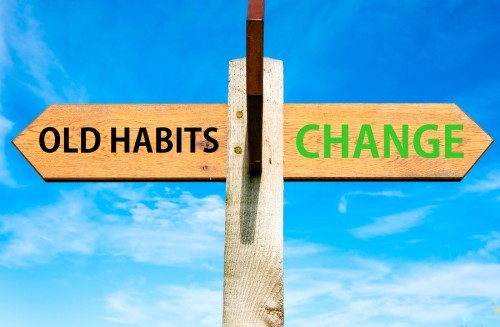 “You will never change your life until you change something you do daily.” ~Mike Murdock
“You will never change your life until you change something you do daily.” ~Mike Murdock
What do we call something we do daily? A habit.
Part of the work of becoming a conscious human being is looking at our habits and patterns and seeing whether they serve us . . . or hold us back.
Sometimes we do things without even knowing why.
I love the story about a mother teaching her ten year-old how to cook a roast. As part of the preparation, the mother cut the ends off the roast before putting it in the pan.
The daughter asked why and the mother replied, “Well, honey, that’s how my mother taught me to do it.”
“But why?” asked the daughter.
“Let’s call up grandma and ask her.”
So they called grandma who replied, “Well, that’s how my mother taught me to do it.”
Next they called great-grandma who gave them her reason: “So it would fit in the pan.”
That isn’t a habit that will hold that family back [other than wasting a good piece of meat].
But it’s an example of things we do without even thinking about it. Perhaps the reason for it has long passed.
Does it make sense any more?
Does it still serve who you are today?
If you want to change your life, you need to change at least one thing you do on a daily basis. Consistency is the key to forming new habits.
“Sow a thought, and you reap an act;
Sow an act, and you reap a habit;
Sow a habit, and you reap a character;
Sow a character, and you reap a destiny.”
~Samuel Smiles
As conscious people, we want to raise our vibrations. And if there are things we’re doing that lower it, we need to change them, such as:
cutting out low vibration foods,
watching our language and thoughts,
reconsidering the people we hang out with? Do they bring our vibration up? Or down? [“You are the average of the five people you spend the most time with.” Jim Rohn]
“Nothing will change unless you make a daily change.” Leo Baubauta
An exercise to change your life
List your personal patterns or habits – things you do every day. In particular, what are things you do every day without thinking about it, from the time you get up.
Then, next to each habit [or activity] write how it benefits you or doesn’t benefit you.
For example: let’s say that each day you have a donut for breakfast. The only benefit I can see is that it temporarily tastes good. But the down side is huge: sugar soaring through your body first thing in the morning and throwing your body chemistry off, weight gain, an energy crash later in the day.
How can you change that habit? Replace the donut with something healthier. Yes, I know apples may not taste as good to you as donuts. At least not at first. But you will reap the rewards in better energy, health and weight loss.
Bill paying: do you pay at the last minute, counting on the post office to get it there on time? And as a result incur late charges that affect your credit rating? Or do you pay early enough for it to be certain to get there on time. Your credit rating may hang in the balance.
Do you have a habit of negative self-talk? Why not focus on changing it to positive and give yourself an attitude boost?
What time do you get up each day? Would a half hour earlier give you more time for important projects?
What time do you eat during the day? Do you eat because you’re hungry or because this is the time everyone else normally eats. Some people have an internal clock that would better serve them in determining meal times.
A French biologist did a study on processional caterpillars who follow one another. He put them into a circle and in the center he put pine needles, which is the food they eat.
Rather than get out of line to go to their food source, they just continued to follow one another walking in a circle until they died!
Is that how you want your life to go? I thought not.
Make a note of your personal patterns and habits and whether it would be good to change any, and how you would change it. You’ll be glad you did.
“A year from now you will wish you had started today.” Karen Lamb
August 12, 2015
What are you getting ready for?

 I recently heard a Chinese saying about Western culture: “People in the West are always getting ready to live.”
I recently heard a Chinese saying about Western culture: “People in the West are always getting ready to live.”
That made me stop and reflect on how much time I have spent “getting ready” for the next direction I want to go in my life.
A fair amount of time, actually. And much of it was wasted time.
In fact, much of it was merely procrastination.
That is why I’ve taken to heart a phrase I heard last year by Steven Pressfield: “Start before you’re ready.”
Do you rush around “getting ready” to find the perfect mate, find the perfect job or house or car?
Or start that creative project?
Do you wait for conditions to be just right to start something new? I used to think I had to create the perfect office environment before I could start writing.
There’s no such thing!
Do you delay taking vacation time until you can afford to go to Paris? When there are perfectly interesting cities and places nearby?
Don’t let excuses hold you back!
I once heard a famous person say she’d like to start meditation, but she wasn’t pure enough yet. The irony is that meditation helps to purify you.
“Start before you’re ready”
The key to getting anything accomplished is consistency: do some of it each day, even if it’s baby steps.
In anticipation of a trip to Mexico later this year, I decided to learn to speak Spanish, so I bought a nice little workbook called Learn Spanish the Fast and Fun Way with MP3 CD: The Activity Kit That Makes Learning a Language Quick and Easy! (Fast and Fun Way Series) and I work in it for 20 minutes a day.
and I work in it for 20 minutes a day.
I could have waited until I have more time, but, the way my life seems to go, that day will never come.
I had other choices: I could have waited until I could afford a fancy audio course, but … why wait?
I could have waited until I could afford to go to Mexico early and take a Spanish language immersion course, but . . . why wait?
I don’t need to get ready to learn Spanish – I just needed to start. And that’s what I’m doing.
My motivation for learning Spanish is that I’m tired of traveling to foreign countries and not being able to speak the language. And yet every country I visit has lots of people who speak English. It’s downright embarrassing.
Two years ago as I was leaving Brazil, the customs agent said something to me in Portuguese and I replied, in English, “I’m sorry I don’t speak Portuguese.”
So he switched to English and gave me a kindly shake of the head that implied, “Shame on you.”
I made the decision right then and there that I would not enter another country without speaking at least a minimal amount of the language.
Your starting point is the next sunrise. Be grateful the sun doesn’t wait to get ready to shine each day. Can you imagine if it did?
“Oh, I won’t rise until all the people on earth appreciate me and are kind to one another and respect Mother Earth.”
That would be a very long wait. Fortunately, the sun is ready to do its job each day, every day, not “getting ready” for conditions to be ideal.
What are your fears of starting?
“At its root, procrastination is almost always based on some kind of fear.” Leo Babauta
Fear of failure: so what? If you’re not failing, you’re not trying. Everyone has some failure [ see my prior post on famous people who failed ].
What if you’re not doing it right? Relax, you’ll figure it out. That’s how babies learn to walk.
Look closely at the fear: what are you afraid of? Is it reasonable? The fear may be based on some incident from childhood that has nothing to do with who you are now.
You’re an adult now, do you want your life to be run by a kindergartner?
“Courage is the willingness to be afraid and act anyway.” Robert Anthony
The antidote to getting ready: Just do it!
Here are some tips to help you get over the “getting ready” syndrome:
Just start: break it down into little steps you can take right now. Even just five minutes a day.
Accountability: do it with a friend.
Glue yourself to your chair and do something for 20 minutes without interruption, then give yourself a break. I set a timer for 20 minutes when I sit down to study Spanish. Knowing the end is in sight helps me start!
 Successful people have no time to “get ready” to succeed – they just launch right in.
Successful people have no time to “get ready” to succeed – they just launch right in.
Self-made billionaire Richard Branson is a prime example.
Branson, who founded Virgin Airlines, was a dyslexic high-school dropout who started one business after another with just a little bit of money. A perfect example of his “just do it” attitude is this story told by Branson, and related by James Clear:
I was in my late twenties, so I had a business, but nobody knew who I was at the time. I was headed to the Virgin Islands and I had a very pretty girl waiting for me, so I was, umm, determined to get there on time.
At the airport, my final flight to the Virgin Islands was cancelled because of maintenance or something. It was the last flight out that night. I thought this was ridiculous, so I went and chartered a private airplane to take me to the Virgin Islands, which I did not have the money to do.
Then, I picked up a small blackboard, wrote “Virgin Airlines. $29.” on it, and went over to the group of people who had been on the flight that was cancelled. I sold tickets for the rest of the seats on the plane, used their money to pay for the chartered plane, and we all went to the Virgin Islands that night.
“Just do it,” says the Nike ad. And there may be no better advice than that.
Richard Branson story courtesy of James Clear at: http://www.businessinsider.com/richard-branson-taught-me-that-successful-people-start-before-theyre-ready-2013-8#ixzz3iSBybE7E
July 29, 2015
Bear Heart’s first job
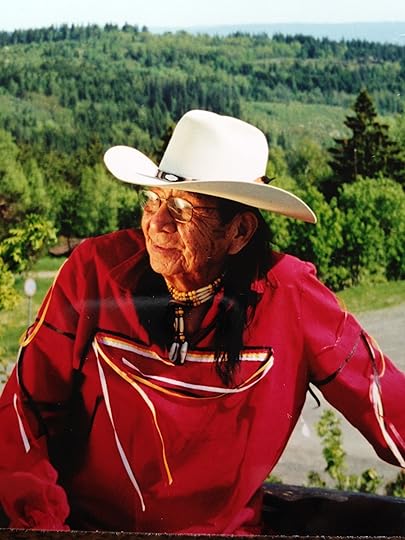
Encouraging a child to earn their own money does more than teach them responsibility. It gives them the confidence to tackle anything. In this lovely excerpt from “The Wind Is My Mother,” Bear Heart tells the story of his first job: earning money planting cotton.
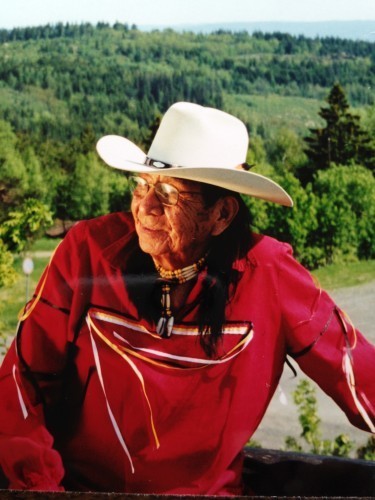 My dad taught me to hitch a team of horses to a wagon and a plow when I was eight years old and when I was ten he gave me two acres of land, saying, “If you want to plant something, go ahead. If you don’t plant anything, let it grow wild. Maybe some rabbits will come, feed upon the plant life and you can kill a rabbit to have something to eat. It’s your choice.”
My dad taught me to hitch a team of horses to a wagon and a plow when I was eight years old and when I was ten he gave me two acres of land, saying, “If you want to plant something, go ahead. If you don’t plant anything, let it grow wild. Maybe some rabbits will come, feed upon the plant life and you can kill a rabbit to have something to eat. It’s your choice.”
Don’t let it sit idle, let it yield something — that’s what he was teaching me.
So I planted two acres of cotton — it was good cotton, my very own, but I had to work it and do all the plowing. I knew which plowshare to use if I wanted to plow deeper and I knew how to plow between each row to lessen the weeds from coming up.
I tied the lines to the horses behind my back — when I hit a root or a rock under the ground it would pull me forward and I’d hit the cross bar on the handles of the plow. Often I’d fall but I’d dust myself off and keep going on.
When the cotton grew up, I’d check each boll to see if there were any boll weevils in there and, if there were, we didn’t have any spray, but at least we could pray.
That’s how I’d tend my two acre cotton patch.
I did my best to excel in everything that I tried, but I definitely must say that I was not good at picking cotton. When I picked cotton from each boll, I’d pick it clean and that takes a long time — it’s stuck in there and you have to pull. The sharp, dried points of the cotton boll stick right under your finger nails and the edge of your fingers get all bloody.
Some people could pick two rows of cotton at once — one cotton sack on their left side and another cotton sack on their right, ambidextrous, going down the line. It would take me about four times as long to finish one row of cotton, just one sack.
Because I had a lot of cousins living nearby, when it was time to pick the cotton I hired them to pick it for me. I was the boss and we all picked the cotton.
When each cotton sack was full, I would weigh it, record the weight next to the person’s name and dump the cotton in the wagon. When we finished picking I sold the cotton and paid them all off. I think the going rate for cotton at that time was about eight cents a pound.
Afterwards, one of my cousins drove me into town from Okemah to Okmulgee and I paid for the gas — it was just 25 cents a gallon in those days. When we got to Okmulgee, I bought a suede jacket and a new pair of work shoes. Boy, I came out the tallest man in that city because I’d bought something with money I earned with my own labor at ten years old.
July 15, 2015
Jimmy Carter on the number one human rights abuse
I just watched former President Jimmy Carter’s May 2015 TED talk entitled, “Why I believe the mistreatment of women is the number one human rights abuse.”
It’s riveting and enlightening [in a dark sort of way]. And it’s something we all need to know about if we are to eliminate such major abuses around the world. Just 16 minutes long, it’s well worth a watch.
July 1, 2015
The History of the U.S. Constitution we weren’t taught in school

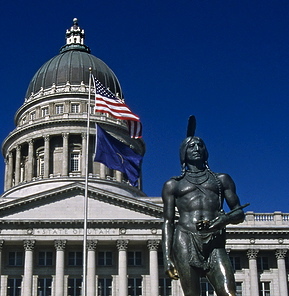 The U.S. Constitution outlines the government of the United States, but very few know it’s actual origins. This post originally appeared on this blog July 2, 2012. It seems worth re-posting every year.
The U.S. Constitution outlines the government of the United States, but very few know it’s actual origins. This post originally appeared on this blog July 2, 2012. It seems worth re-posting every year.
If you’re like me, I learned in grade school that the U.S. Constitution was based on ancient Greek democracy. Which was a creative stretch of the truth, since ancient Greece was not a democracy.
My research as to what children are taught today about the origin of our government is also disappointing.
Apparently the Founding Fathers simply created it out of thin air, or were influenced by European governments even though there was no democracy anywhere in Europe at that time.
The True History of our Constitution
The truth is that the U.S. Constitution is modeled in both principle and form on the Great Law of Peace of the Native American tribe known as the Iroquois.
This is absolutely, unequivocally historical fact.
In 1987, the United States Senate acknowledged that the Great Law of Peace of the Iroquois Nations served as a model for the Constitution of the United States. (U.S. S. Con. Res. 76, 2 Dec. 1987).
And since the U.S. Constitution was a model for the charter of the United Nations, the Iroquois Great Law of Peace is also a basis of international law.
When the Founding Fathers looked for examples of effective government and human liberty upon which to model a Constitution to unite the thirteen colonies, they found it in the government of the Iroquois Nation.
In the 18th Century, the Iroquois League was the oldest, most highly evolved participatory democracy on Earth.
I find it sad that the true story is still not taught in all our schools. But here it is:
The Peacemaker and the Great Law of Peace

The Peacemaker
In the 12th Century, five tribes in the northeastern U.S. were constantly at war: the Mohawks, Seneca, Oneida, Onondaga and Cayugas. The wars were vicious and, according to tribal history, included cannibalism.
One day, a canoe made of white stone carried a man, born of a virgin, across Onondaga Lake to announce The Good News of Peace had come and the killing and violence would end.
He traveled from tribe to tribe over the course of years, preaching peace because peace was the desire of the Creator. Oral tribal history says it may have taken him 40 years to reach everyone and get agreement from all five tribes.
This man became known as The Peacemaker.
Eventually, the five tribes agreed to the Great Law of Peace and became known collectively as the Haudenosaunee, which means People of the Long House. Outsiders refer to them as Iroquois.
[In 1722, the Tuscarora joined the Confederacy so today it’s known as the Six Tribes of the Iroquois Confederacy].
The Great Law of Peace was a vehicle for creating harmony, unity and respect among human beings.
Its recognition of individual liberty and justice surpasses that of many democracies.
The Great Law of Peace includes:
freedom of speech,
freedom of religion,
the right of women to participate in government,
separation of powers,
checks and balances within government.
a government “of the people, by the people and for the people,”
three branches of government: two houses and a grand counsel,
A Women’s Council, which is the Iroquois equivalent of our Supreme Court –settling disputes and judging legal violations.
The central idea underlying Iroquois political philosophy is that peace is the will of the Creator, and the ultimate spiritual goal and natural order among humans.
The Founding Fathers’ consultation with the Iroquois
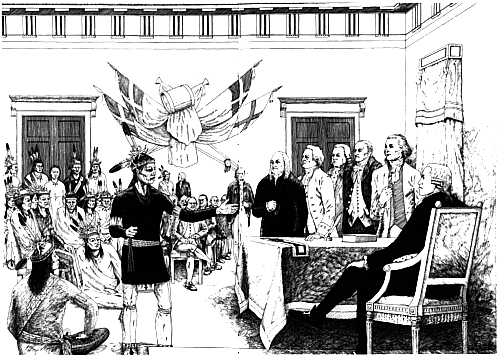 For decades, the Iroquois had urged the English colonists to unite together as one independent and free people.
For decades, the Iroquois had urged the English colonists to unite together as one independent and free people.
George Washington, Ben Franklin and Thomas Jefferson met frequently with the Iroquois and made themselves very familiar with the Great Law of Peace.
Washington expressed “great excitement” over the two houses and Grand Counsel.
Several delegates from the Iroquois Confederacy attended the Continental Congress in 1776 as it wrote the Declaration of Independence and drafted the Constitution of the United States, modeling it on the Iroquois Constitution.
Three weeks later, the Declaration of Independence was signed, and the United States of America was born.
What got left out of the U.S. Constitution
In fact, just about the only parts of the Great Law of Peace that our founding fathers didn’t incorporate were these:
1) The Seventh Generation principle: The Constitution of the Iroquois Confederacy states that chiefs consider the impact of their decisions on the seventh generation to come.
2) The role of women: Clan mothers choose candidates [who are male] as sachems [political leaders]. The women maintain ownership of land and homes, and exercise veto power over any council action that may result in war. The women can also impeach and expel any leader who conducts himself improperly or loses the confidence of the electorate; then the women choose a new leader.
Imagine how different our world would be today if our government had included these principles from the start.
The symbols
The Peacemaker designated The Tree of Peace as a symbol of the Great Law of Peace — a great white pine tree whose branches spread out to shelter all nations who commit themselves to Peace.
Beneath the tree the Five Nations buried their weapons of war.
Atop the tree is the Eagle-that-sees-far.
There is a bundle of five arrows tied together to represent strength of five tribes bound together in peace.
Four long roots stretch out in the four sacred directions—the “white roots of peace.”
Thomas Jefferson adopted the symbols of the Peacemaker legend.
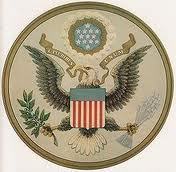 The Tree of Peace became the Liberty Tree displayed on colonial flags.
The Tree of Peace became the Liberty Tree displayed on colonial flags.
Eagle-that-sees-far became the American Eagle, still a symbol of American government.
On the U.S. Great Seal, the American Eagle clutches a bundle of thirteen arrows, representing the original colonies.
Our eagle also holds an olive branch symbolizing that the United States of America has “a strong desire for peace, but will always be ready for war.”
Separate leaders for war and peace
There’s no separation of church and state in Iroquois society; spirituality lies at the root of government and law.
However, the Iroquois Confederacy, as with most tribes, had separate leaders for war and peace. As a lawmaker, the sachem could never go to war in his official capacity as sachem. If disposed to take the warpath, he laid aside his civil office for the time being, and became a common warrior.
The colonists followed this model too. The inability to separate the civil government and military has doomed many imitators of American democracy, particularly in Africa and Latin America.
The three principles of the Great Law of Peace
1) Righteousness, meaning people must treat each other fairly. “Each individual must have a strong sense of justice, must treat people as equals and must enjoy equal protection under the Great Law.”
2) Health: “Health means that the soundness of mind, body and spirit will create a strong individual. Health is also the peacefulness that results when a strong mind uses its rational power to promote well-being between peoples, between nations.”
3) Power: “The laws of the Great Law provide authority, tradition and stability if properly respected in thought and action. Power comes from the united actions of the people operating under one law, with one mind, one heart, and one body. Such power can assure that justice and healthfulness continue. People and nations need to exercise just enough power to maintain the peace and well-being of the members of the Confederacy.”
It’s the omission of these three principles, the seven generations rule and the role of women that cause Native Americans today to say that, the U.S. copied the Great Law of Peace but didn’t really understand it.
So our forefathers copied the Great Law of a people whose country we stole and against whom our government committed genocide, and then kept it a secret.
It just makes me want to cry.
Please teach your children the truth of the history of our great country.
June 24, 2015
Ten Commandments of Climate Change from Pope Francis

 Well, just when I thought Pope Francis couldn’t be any cooler, he has come out with an eloquent 10 commandments for stopping climate change and the “disturbing warming” of our planet.
Well, just when I thought Pope Francis couldn’t be any cooler, he has come out with an eloquent 10 commandments for stopping climate change and the “disturbing warming” of our planet.
One would think he was Native American.
These 10 commandments were part of a 182-page encyclical on climate change entitled “Laudato Si [Praised Be To You]; On Care for Our Common Home.”
Encyclicals are teaching documents traditionally addressed to Catholics worldwide, but this one was addressed to “every person living on this planet.”
In it, he said, “The Earth, our home, is beginning to look more and more like an immense pile of filth. In many parts of the planet, the elderly lament that once beautiful landscapes are now covered with rubbish.”
Here are His Ten Commandments of Climate Change
One: Think of future generations.
“What kind of world do we want to leave to those who come after us, to children who are now growing up?”
Two: Embrace alternative energy sources.
“We know that technology based on the use of highly polluting fossil fuels – especially coal, but also oil and, to a lesser degree, gas – needs to be progressively replaced without delay.”
Three: Consider pollution’s effect on the poor.
“Touch the hearts of those who look only for gain at the expense of the poor and the earth.”
Four: Take the bus!
“Many specialists agree on the need to give priority to public transportation.”
Five: Be humble.
“We are not God. The earth was here before us and it has been given to us.”
 Six: Don’t become a slave to your phone.
Six: Don’t become a slave to your phone.
“True wisdom… is not acquired by a mere accumulation of data which eventually leads to overload and confusion, a sort of mental pollution.”
Seven: Don’t trade online relationships for real ones.
“Real relationships tend to be replaced by a type of internet communication which enables us to choose or eliminate relationships at whim.”
Eight: Turn off the lights, recycle and don’t waste food.
“[Environmental responsibility can] significantly affect the world around us, such as avoiding the use of plastic and paper, reducing water consumption, separating refuse, cooking only what can reasonably consumed… planting trees, turning off unnecessary lights.”
Nine: Educate yourself.
“There is a nobility in the duty to care for creation through little daily actions, and it is wonderful how education can bring about real changes in lifestyle.”
Ten: Believe you can make a difference.
“We must regain the conviction that we need one another, that we have a shared responsibility for others and the world, and that being good and decent are worth it.”
Pope Francis has also said that Indigenous Peoples should be “principal dialog partners,” particularly when large projects affecting their land are proposed.
“For them, land is not a commodity but rather a gift from God and from their ancestors who rest there… When they remain on their land, they themselves care for it best.”
And I close with this from shamanic teacher and author Sandra Ingerman in Walking in Light: The Everyday Empowerment of a Shamanic Life :
:
“On a spiritual level the extreme changes in the climate are mirroring back to us the imbalance of how we live. The Salish people of the northwest use the word skalatitude. This is a powerful word that means when people and nature are in perfect harmony, then magic and beauty are everywhere.”





